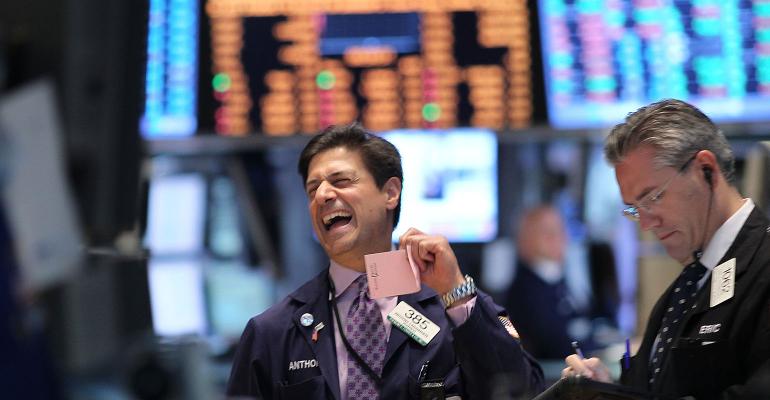By Mohamed A. El-Erian
(Bloomberg View) --The outcome of the Italian referendum last week added to the political, economic and financial uncertainty facing Europe, the world’s largest economic region. Nonetheless, global equity markets shrugged off the turbulence even more quickly than they overcame the shock of the Brexit vote in June.
As a result, U.S. indexes have surged to new highs, adding to an impressive run. Understanding what is, and isn't, at work in this dynamic sheds light on what’s ahead, including ways to reinforce what, until now, have been “fortress markets.”
The performance of U.S. stocks has been inspiring. In November alone, the Dow Jones Industrial Index recorded a 6.4 percent increase, to a historic high of 19,192 points. The upward trend has continued in December, with the Dow closing last week at a new record of almost 20,000, having gained almost 8 percent since the Nov. 8 elections. In doing so, the index has now risen in 20 of the last 24 trading sessions, registering 13 record highs in that period.
This remarkable run is not because stocks started the year trading at historically cheap levels. If anything, eight years into this rally, most valuation metrics are flashing yellow, if not red. Even the considerable support that stocks have received from ultra-low yields is dissipating now that interest rates have risen around the world.
It is also hard to point to rapidly improving fundamentals as the cause. Growth in the world economy is still stuck in low gear, though expectations for U.S. nominal gross domestic product have brightened somewhat because of both its growth and inflation components. This follows President-elect Donald Trump's emphasis on infrastructuhttps://www.bloomberg.com/view/articles/2016-12-12/how-to-make-this-stock-market-rally-lastre, corporate tax reform and deregulation, together with a relative easing of his anti-trade campaign rhetoric.
Finally, this bull market is not linked to an impending increase in central bank liquidity support for markets. Instead, it is highly likely that the Federal Reserve will raise interest rates by 25 basis points this week, only the second hike in 10 years. Meanwhile, the European Central Bank last week reduced the pace of its monthly purchases of securities, whether you call it a “taper” or a “trim.”
What is primarily driving stocks is a hope trifecta that relates to liquidity, growth and inflation.
With significantly better prospects for the repatriation of corporate cash held abroad, markets are expecting an increase in the support that equity valuations receive from stock repurchases, dividends, and mergers and acquisitions, all of which would extend and reinforce unprecedented liquidity injections from both the private and public sectors. This amplifies the notable impact of the more favorable economic growth/corporate earnings expectations fueled by the president-elect’s policy announcements.
Yet, as remarkable as it has been, the beneficial influence of liquidity support and policy expectations need to be reinforced by the realization of improved fundamentals that anchor the notion of fortress markets, particularly in view of the considerable uncertainties facing Europe. For that to occur, the recent pro-growth announcements need to translate into detailed design and sustained political implementations, which the highly polarized U.S. Congress has made notably elusive in recent years.
Recent market movements reflect the view that Trump’s surprise election serves as a beneficial “endogenous disruption” to the political class -- in other words, a shock that helps reduce paralyzing dysfunction and restores better economic governance. Republican majorities in both houses of Congress -- together with some low-hanging fruit in the areas of tax reform, deregulation and infrastructure -- provide further justification for the markets' optimism. Successful implementation, followed by efforts to take on more difficult policy measures, are the key to turning this optimism into reality.
But if better policies fail to reinforce the impact of favorable liquidity injections, the markets could suffer the fate of the unfortunate Black Knight in "Monty Python and the Holy Grail."
In a scene of this iconic movie, the Black Knight blocks the path of King Arthur. Refusing to yield, he loses his arms and his legs in a sword fight. But rather than acknowledge his vulnerability, the knight goes from claiming that his wounds are “but a scratch” to asserting that they are "just a flesh wound,” adding that, although he has lost all his limbs, he is “invincible.”
Underpinned by better economic and financial fundamentals, markets can turn liquidity-induced strength into something a lot more durable and reliable. For that to happen, the current political shock needs to result in the type of economic governance that Congress is capable of, but has not shown for too many years.
This column does not necessarily reflect the opinion of the editorial board or Bloomberg LP and its owners.
Mohamed A. El-Erian is a Bloomberg View columnist. He is the chief economic adviser at Allianz SE and chairman of the President’s Global Development Council, and he was chief executive and co-chief investment officer of Pimco. His books include “The Only Game in Town: Central Banks, Instability and Avoiding the Next Collapse.”
To contact the author of this story: Mohamed A. El-Erian at [email protected] To contact the editor responsible for this story: Max Berley at [email protected]
For more columns from Bloomberg View, visit Bloomberg view





